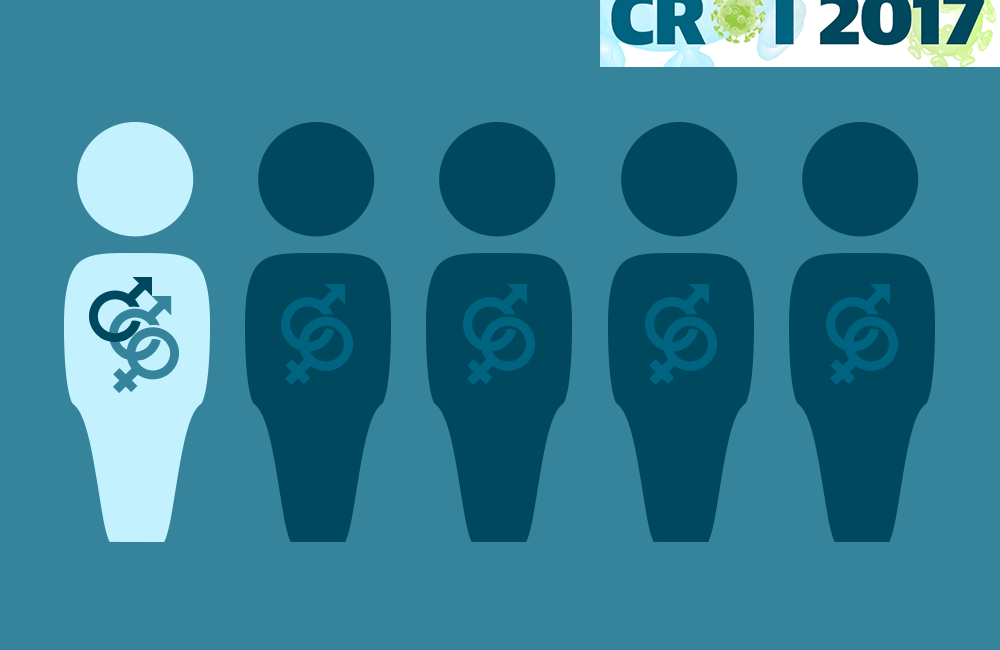
A genetic analysis of a large database of people with HIV in the UK in care shows that 18% of men with HIV who claim to be exclusively heterosexual in fact belong to clusters of linked infections that consist only of men.
This provides a minimum figure for the proportion of men with HIV in the UK who are what the researchers call “undisclosed men who have sex with men (MSM)”. It is a minimum figure because other men who caught HIV through sex with another man may be in mixed-gender clusters.
The data were presented by Manon Ragonnet-Cronin and colleagues from Edinburgh University at the 2017 Conference on Retroviruses and Opportunistic Infections (CROI) last week.
A second analysis of the same data found that undisclosed MSM were more likely to be the linking partner between a disclosed MSM and a woman than a woman was to be the link between a disclosed bisexual man and a heterosexual man.
The phylogenetic analysis looked at the 50,025 genetic sequences of HIV subtypes A1, B and C from the UK HIV Drug Resistance Database, which contains sequences from 60% of all people with HIV in the UK (another 10,000 sequences belonging to other subtypes of HIV were not included).
Someone was counted as being in a “cluster” if their HIV shared a common ancestor with another person’s HIV in the last five years, so, for the purpose of this analysis, a “cluster” had to include at least three people.
There were 223 male-only clusters altogether containing 1204 men (average, 5.4 per cluster). The total number of self-declared heterosexual men who belonged in a cluster, whether male-only or mixed, was 1341.
However, 249 of these supposedly heterosexual men actually belonged to all-male clusters, meaning that 18% of heterosexual men were in fact probably non-disclosed MSM (ndMSM).
These ndMSM were considerably more likely to be of black African ethnicity rather than any other ethnic background. They were also very much less likely to have had a recent HIV infection: only 12.5% had a recent infection versus 75% of declared MSM. This could mean two things, both of which could be true: ndMSM are much more likely to be late presenters, and may also be older than declared MSM.
The ndMSM were much more likely to be peripheral rather than central to clusters. They were twice as likely as declared MSM to be on the edge of clusters, i.e. only linked to it by one partner. This implies they have fewer partners and may be less likely to transmit HIV.
However, they were also highly “assortative”, which means they were much more likely to be linked to another ndMSM than if mixing was random, and if they were linked to more than one partner, it was much more likely that at least one of them was another ndMSM.
This analysis only measures supposedly heterosexual men who only had male contacts. However, there has been concern since the epidemic began that bisexual men, whether open or ‘closet’, could be links between the gay population and the general population. This has proven not to be a major issue in countries with concentrated epidemics but can become a factor in countries with more generalised ones.
The researchers therefore did an analysis of the relatively few clusters of three or more people in the network where “bridging” between declared MSM and heterosexual women or men did happen.
They counted two types of linkage. In one, the woman was a link between an openly bisexual MSM and a heterosexual man, i.e. she appeared likely to have received her infection from one and passed it on to the other. In the second, a man who said he was heterosexual was a link between a declared MSM and a woman, so likely caught HIV from one and passed it on to the other. Note that neither of these configurations can show who infected who: establishing direction of infection in phylogenetic analysis is much more difficult than demonstrating linkage.
The configuration in which the man was in the middle and therefore most likely a non-disclosed MSM was 2.24 times more likely than the one where the woman was in the middle. Of the 1341 male heterosexuals in clusters, 54 (4%) linked MSM with women. In contrast only 32 out of 1711 women in clusters (1.9%) were the linking person between a declared MSM and a heterosexual man.
This study provides a considerably higher estimate of the proportion of ‘heterosexual’ men with HIV in the UK who are in fact undisclosed MSM than a previous study in 2014. This estimated the proportion as 6%, though it did estimate that the proportion of ndMSM among black African men was as high as 21%. However, this study only looked at HIV subtype B infections, and would therefore tend to miss more infections in non-whites, who are likely to have other subtypes.
It would be interesting to see an analysis of all subtypes, which would include subtype D (also common in parts of east Africa, and increasingly in the Middle East) and subtype AE (which is the predominant type in both heterosexuals and MSM in south-east Asia.)
Ragonnet-Cronin M et al. Non-disclosed MSM link together in HIV transmission networks. Conference on Retroviruses and Opportunistic Infections (CROI 2017), Seattle, abstract 186, 2017.
